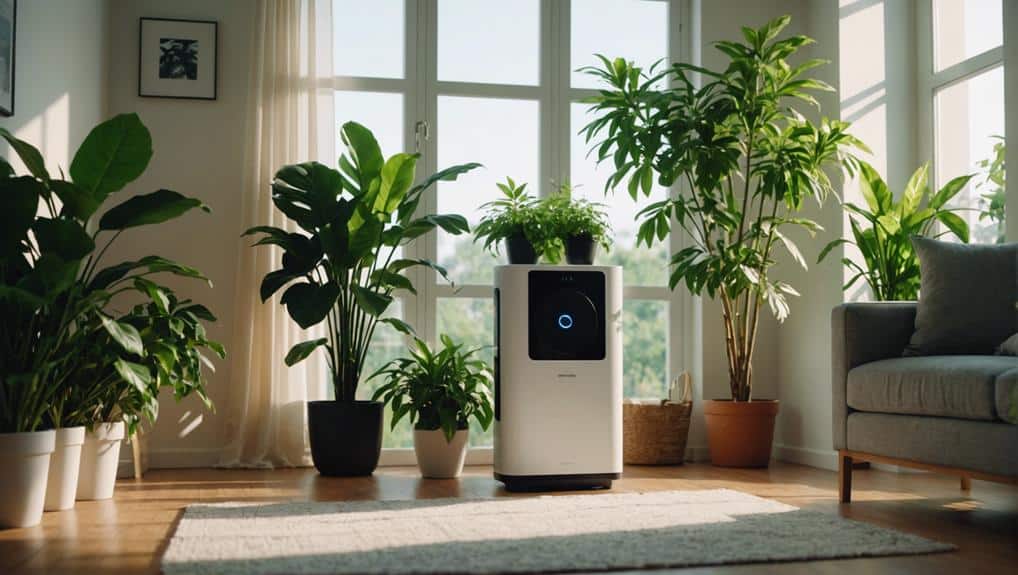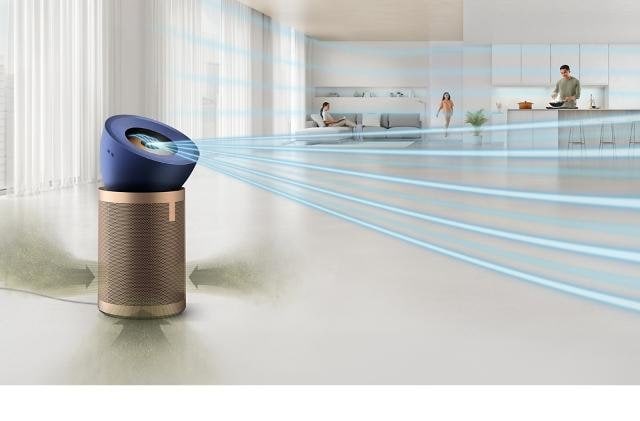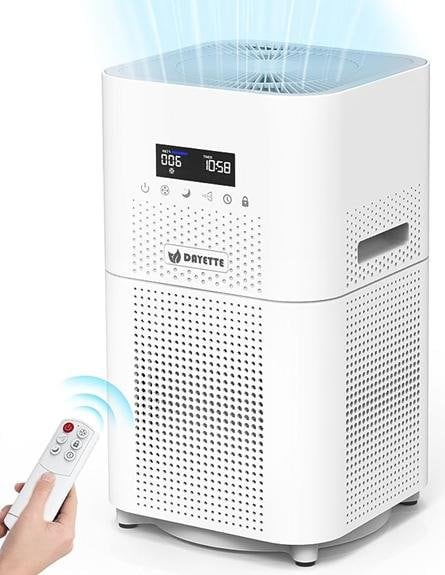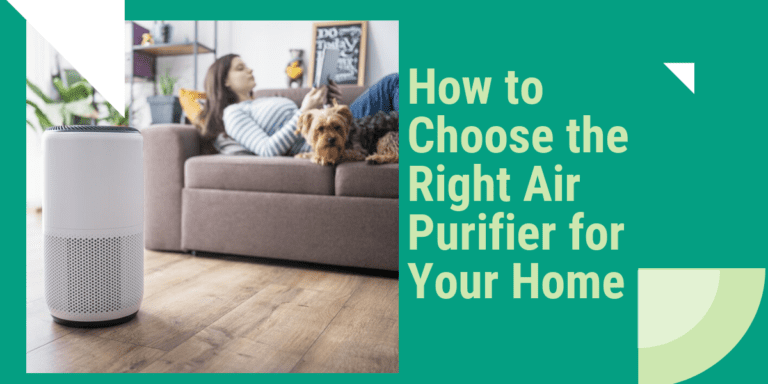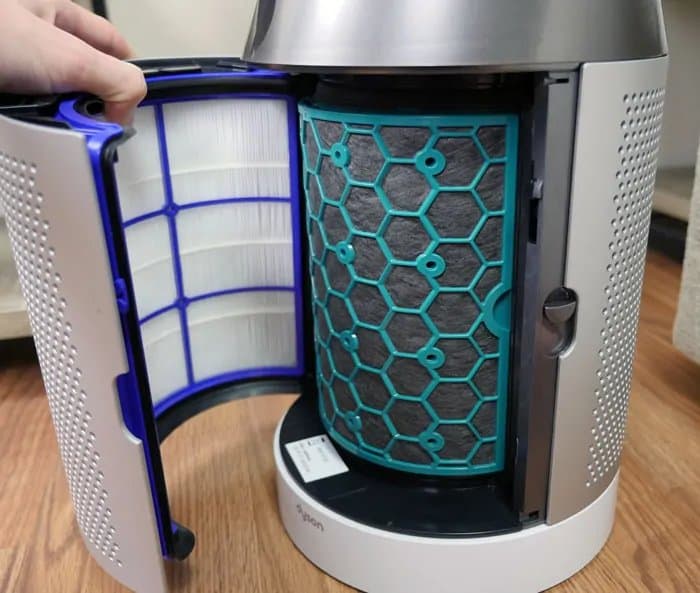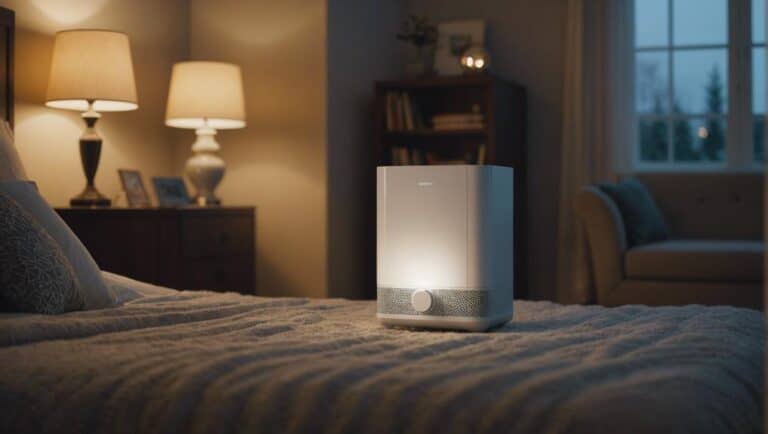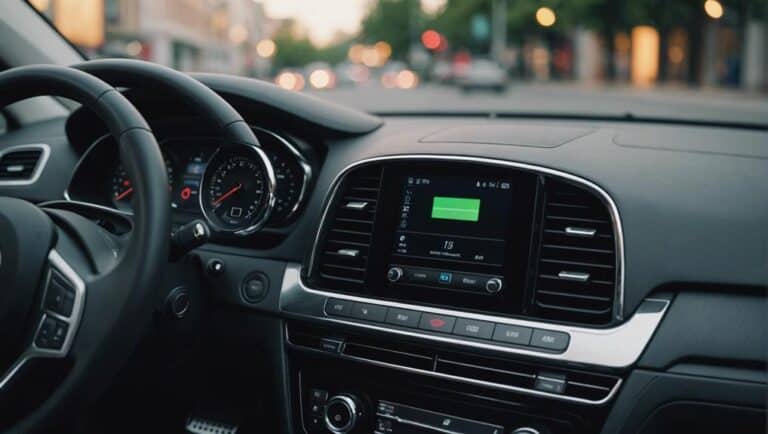How to Maximize Indoor Air Quality Using an Air Purifier
When it comes to maximizing indoor air quality with an air purifier, we understand the importance of selecting the right model for peak performance. However, there’s a key factor that often gets overlooked but can greatly impact the air you breathe. Curious to uncover this essential element that could make all the difference in your quest for cleaner indoor air? Stay tuned for an important insight that might just surprise you.
Choosing the Right Air Purifier
Have you ever wondered how to select the most suitable air purifier for your indoor space? When choosing an air purifier, it’s important to take into account several key factors to guarantee excellent performance.
Initially, look for air purifiers with HEPA filters, as they can effectively capture particles as small as 0.3 microns, including allergens and pollutants. Additionally, consider the room size and CADR rating of the air purifier to ensure sufficient coverage and efficient pollutant removal.
Moreover, evaluate the noise levels of the air purifier, especially if you plan to use it in a bedroom or office where quiet operation is essential. Take into account the gas removal capabilities of the purifier to effectively eliminate harmful gases and odors from your indoor environment.
When selecting an air purifier, also explore the various placement options available to ensure proper circulation and efficient air cleaning. Finally, look for the ENERGY STAR label on air purifiers to promote energy efficiency and environmental sustainability. By taking these factors into account, you can choose the right air purifier for your specific needs and maximize indoor air quality.
Proper Placement for Efficient Circulation
Properly positioning your air purifier is essential for maximizing air circulation and ensuring efficient removal of pollutants. To achieve maximized distribution of clean air, consider the following placement tips:
- Center Stage: Place the air purifier in the center of the room to allow for even distribution of purified air throughout the space. This placement facilitates better air circulation and guarantees that all corners receive adequate filtration.
- Avoid Obstacles: Steer clear of walls, furniture, and other obstructions that can obstruct airflow. Placing the air purifier in an open area prevents barriers that could hinder the unit’s effectiveness in capturing pollutants.
- Strategic Placement: In larger rooms, strategically position multiple air purifiers to cover the entire area thoroughly. This approach ensures thorough filtration and maximizes the removal of contaminants, promoting cleaner indoor air for improved health outcomes.
Continuous Operation for Clean Air
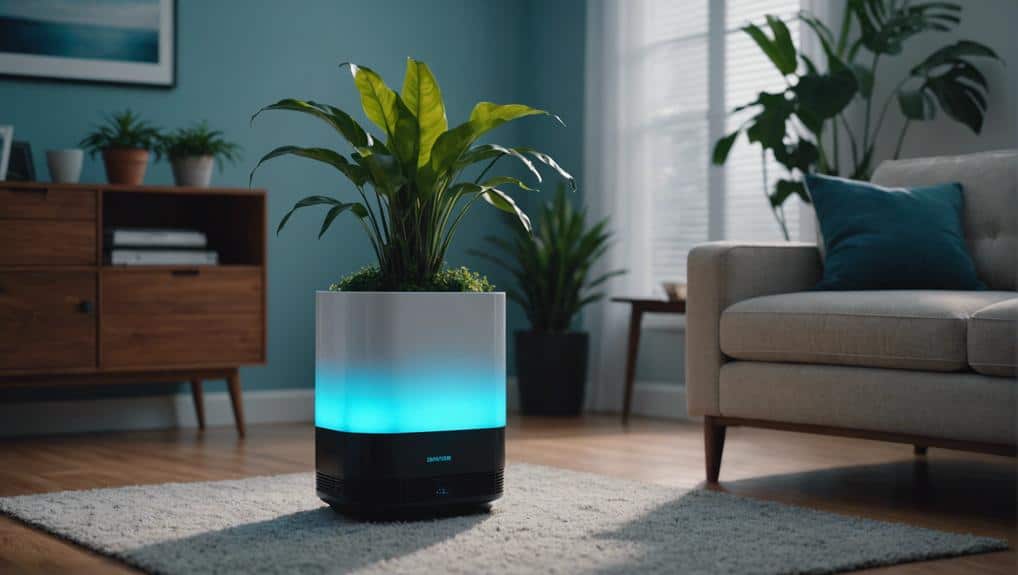
To maintain consistent indoor air quality and effectively filter out pollutants 24/7, it’s essential to run an air purifier continuously. Continuous operation guarantees that allergens, dust, and contaminants are consistently removed from the air, creating a cleaner environment.
For individuals concerned about respiratory health or allergies, this continuous cleaning process is vital. By keeping the air free from these irritants through uninterrupted operation, you can breathe easier and enjoy fresher air.
Additionally, air purifiers designed with low noise levels allow for quiet, continuous operation without causing disturbances. By maintaining this consistency in running your air purifier, you’re actively taking control of your indoor air quality and promoting better respiratory health.
Regular Filter Replacement Maintenance
We understand that maintaining regular filter replacement is essential for keeping our air purifiers working effectively. Changing filters every 60-90 days, or sooner if visibly dirty, guarantees peak performance.
It’s important to install the correct filters properly to maximize the benefits of high-efficiency systems.
Filter Replacement Frequency
Ensuring the timely replacement of air purifier filters is crucial for maintaining excellent indoor air quality. When it comes to filter replacement frequency, consider the following:
- Follow Manufacturer’s Recommendations: Most air purifier manufacturers suggest replacing filters every 6 to 12 months to uphold peak air purification efficiency.
- Monitor Air Quality: Keep an eye on your indoor air quality and adjust the replacement frequency accordingly based on factors like pollution levels and allergen presence.
- Consider Usage and Filter Type: Filters in high-usage areas or specific filter types may require more frequent replacement to ensure consistent air purification performance.
Correct Filter Installation
For ideal air purification efficiency, proper filter installation is essential in maintaining indoor air quality. To guarantee the air purifier functions effectively, it’s important to follow the manufacturer’s guidelines for filter installation.
Regular replacement of filters, typically every 6-12 months based on air quality conditions and usage, is crucial in preventing a decrease in the air purifier’s efficiency. Dirty filters can impede the removal of contaminants from the air, impacting indoor air quality.
Quality Filter Brands
Maintaining excellent indoor air quality through regular filter replacement is greatly influenced by the choice of quality filter brands like HEPA filters, known for their high capture rate of particles. When selecting filter brands, consider the following:
- Efficient Filtration: HEPA filters can capture up to 99.97% of airborne particles, ensuring cleaner air for your indoor environment.
- Manufacturer’s Recommendations: Adhering to the manufacturer’s guidelines for filter replacement intervals is essential for best performance and effective filtration.
- Reduced Airborne Particles: Timely filter replacements, typically every 60-90 days, help minimize airborne particles, promoting healthier indoor air quality.
Importance of HEPA Filters
Utilizing HEPA filters in air purifiers greatly enhances indoor air quality by efficiently capturing various particles, from common allergens to microscopic viruses and bacteria. HEPA filters can trap particles as small as 0.3 microns, including allergens, dust, and pet dander, at an efficiency rate of up to 99.97%. These filters excel at capturing Most Penetrating Particle Size (MPPS) particles, thereby improving indoor air quality to a large extent. Furthermore, HEPA filters have the ability to capture even smaller particles down to 0.1 micron, such as viruses and bacteria, which contributes to creating a healthier living environment. By reducing airborne pollutants, HEPA filters aid individuals with respiratory conditions by providing relief and promoting better respiratory health and overall well-being.
| HEPA Filter Benefits | Description |
|---|---|
| Particle Capture | Efficiently captures allergens, dust, pet dander, viruses, and bacteria |
| Respiratory Health | Reduces airborne pollutants, promoting better respiratory health |
| Improved Indoor Air Quality | Enhances indoor air quality by removing contaminants and allergens |
| Efficiency Rate | Up to 99.97% efficiency in trapping particles as small as 0.3 microns |
Effective Removal of Airborne Particles
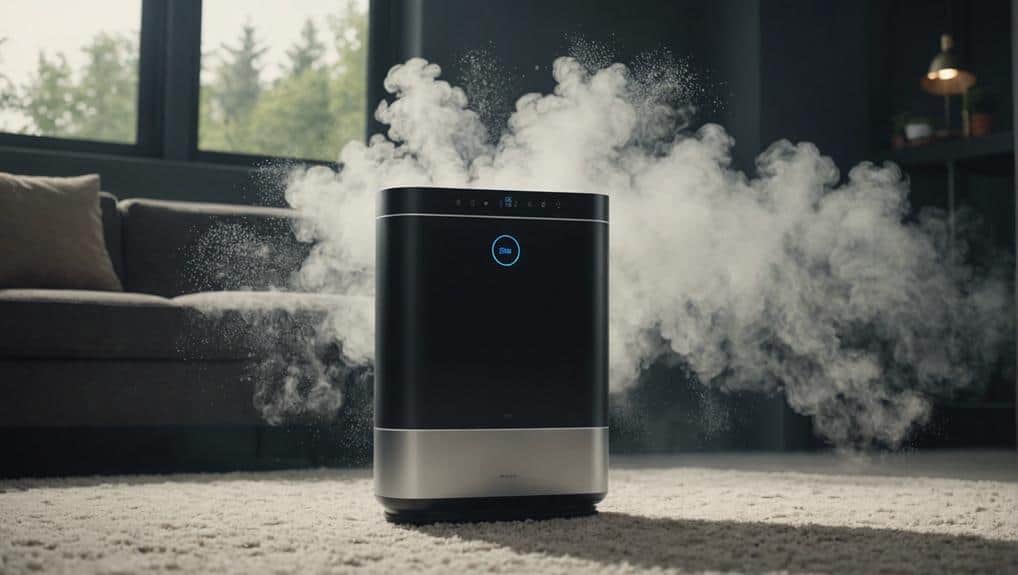
When it comes to effective removal of airborne particles, we need to take into account the various particle filtration methods available. HEPA filter technology plays an important role in capturing particles as small as 0.1 micron, including viruses and bacteria.
Our focus will be on discussing how air purifiers efficiently remove a wide range of airborne pollutants, contributing to improved indoor air quality.
Particle Filtration Methods
To improve indoor air quality, effective particle filtration methods play a crucial role in capturing a wide range of airborne particles, including dust, pollen, pet dander, viruses, and bacteria.
When considering air purifiers for particle removal, key factors to focus on include:
- HEPA Filters: These filters, commonly found in air purifiers, can capture particles as small as 0.3 microns, such as dust, pollen, and pet dander.
- Effective Trapping of Viruses and Bacteria: Air purifiers equipped with HEPA filters are capable of trapping particles as small as 0.1 micron, including viruses and bacteria, contributing to cleaner indoor air quality.
- Pre-Filters for Larger Particles: Utilizing pre-filters in air purifiers helps capture larger particles like hair, dust, pet fur, and dirt before they reach the main filter, enhancing the overall efficiency of the filtration system.
HEPA Filter Technology
How does HEPA filter technology effectively remove airborne particles to enhance indoor air quality?
HEPA filters have an remarkable ability to capture particles as small as 0.3 microns with an efficiency of up to 99.97%. By effectively trapping common allergens such as pollen, dust mites, pet dander, and mold spores, HEPA technology plays an essential role in safeguarding respiratory health.
Air purifiers equipped with HEPA filters are highly recommended for individuals with allergies and asthma due to their high filtration efficiency. This technology greatly improves indoor air quality by removing harmful airborne particles, making the air cleaner and safer to breathe.
HEPA filters are a reliable choice for those seeking better control over their indoor environment’s air quality.
Airborne Pollutants Removal
Eliminating airborne pollutants effectively is essential for maintaining excellent indoor air quality and promoting overall respiratory health. When using air purifiers to combat airborne pollutants, consider these strategies to enhance air quality and well-being:
- Leverage HEPA Filters: HEPA filters in air purifiers excel at capturing particles as small as 0.1 micron, including viruses and bacteria, aiding in the removal of allergens like pollen and dust mites.
- Utilize Multiple Filtration Layers: Opt for air purifiers with pre-filters and HEPA filters to effectively trap various pollutants, ensuring cleaner air for improved respiratory health.
- Activate Carbon Filters: Activated carbon filters play a vital role in eliminating odors, pet dander, and hair, thereby enhancing indoor air quality.
Size Considerations for Room Coverage
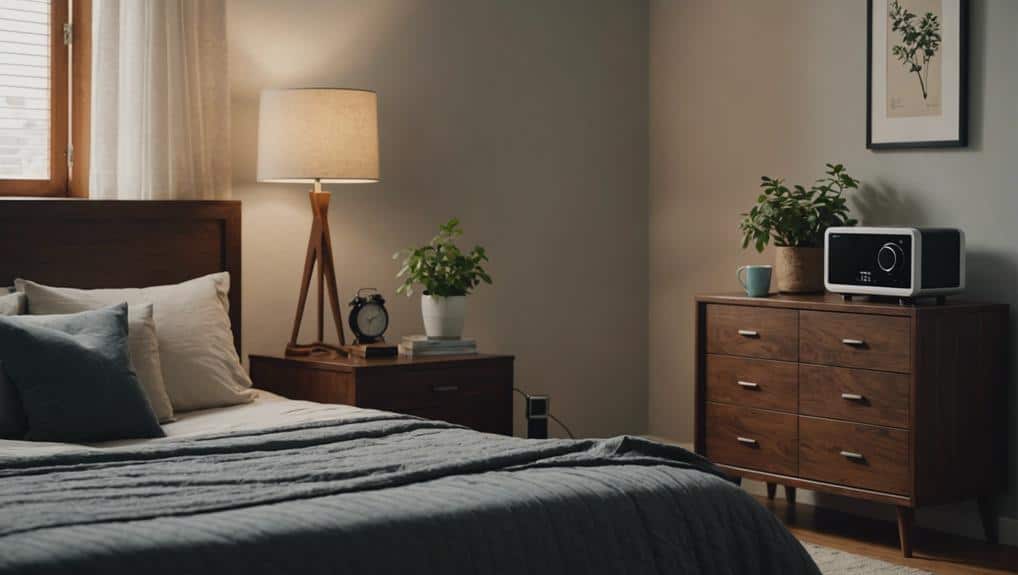
Taking into account the CADR rating of an air purifier when choosing the right size for a room is crucial for optimizing indoor air quality. The CADR rating indicates the air purifier’s capability to clean the air efficiently in specific room sizes. Higher CADR ratings are more suitable for larger rooms as they can purify the air faster.
When selecting an air purifier, consider factors such as room size and air changes per hour (ACH) to make sure it can effectively remove airborne pollutants. Matching the air purifier’s room coverage to the designated space guarantees maximum filtration benefits.
Optimizing Indoor Air Quality
To enhance indoor air quality effectively, consider utilizing air purifiers equipped with advanced filtration technologies. When optimizing indoor air quality, it’s essential to focus on specific features and practices that can make a significant difference. Here are key strategies to maximize the effectiveness of air purifiers:
- Utilize HEPA filters: HEPA filters are highly efficient at capturing tiny particles like allergens, dust, and even bacteria, ensuring cleaner and healthier air for you and your family.
- Incorporate activated carbon filters: Activated carbon filters excel at removing odors and volatile organic compounds (VOCs) from the air, promoting a fresher indoor environment free from unpleasant smells.
- Regular filter replacement and maintenance: Consistent filter replacement is vital to maintain the top performance of your air purifier. By keeping the filters clean and up to date, you can effectively reduce respiratory symptoms, allergies, and asthma triggers, leading to an improved overall quality of life.
Conclusion
To sum up, it’s crucial to select the right air purifier with a HEPA filter, position it correctly in the center of the room, keep it running continuously, and regularly replace filters. By following these steps, indoor air quality can be effectively enhanced.
This process helps eliminate airborne pollutants and allergens, leading to cleaner air and improved respiratory health. Prioritizing indoor air quality is key to creating a healthier living environment.
